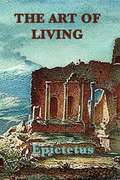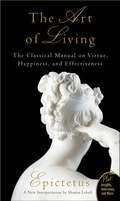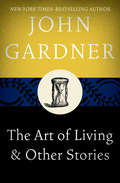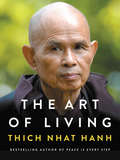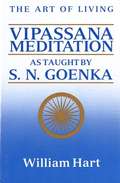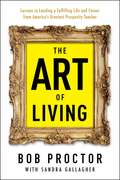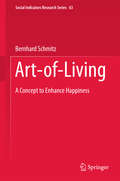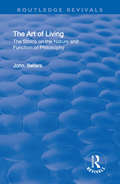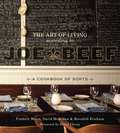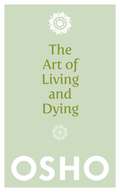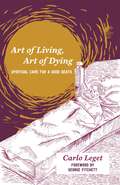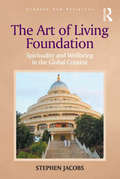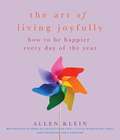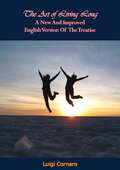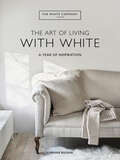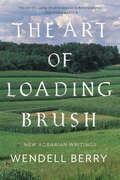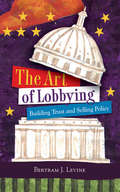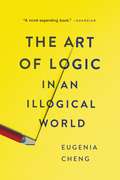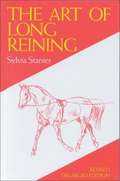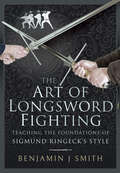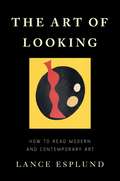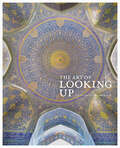- Table View
- List View
The Art of Living
by EpictetusNo writings of Epictetus himself are really known. His discourses were transcribed and compiled by his pupil Arrian (author of the Anabasis Alexandri). The main work is The Discourses, four books of which have been preserved (out of an original eight). Arrian also compiled a popular digest, entitled the Enchiridion, or Handbook. In a preface to the Discourses, addressed to Lucius Gellius, Arrian states that "whatever I heard him say I used to write down, word for word, as best I could, endeavouring to preserve it as a memorial, for my own future use, of his way of thinking and the frankness of his speech."
The Art of Living: The Classical Mannual on Virtue, Happiness, and Effectiveness (Plus Ser.)
by EpictetusEpictetus was born into slavery about A. D. 55 in the eastern outreaches of the Roman Empire. Sold as a child and crippled from the beatings of his master, Epictetus was eventually freed, rising from his humble roots to establish an influential school of Stoic philosophy. Stressing that human beings cannot control life, only how they respond to it, Epictetus dedicated his life to outlining the simple way to happiness, fulfillment, and tranquility. By putting into practice the ninety-three witty, wise, and razor-sharp instructions that make up The Art of Living, readers learn to successfully meet the challenges of everyday life and face life's inevitable losses and disappointments with grace. Epictetus's teachings rank among the greatest wisdom texts of human civilization. Sharon Lebell presents this esteemed philosopher's invaluable insights for the first time in a splendidly down-to-earth rendition. The result is the West's first and best primer for living the best possible life -- as helpful in the twenty-first century as it was in the first.
The Art of Living: & Other Stories
by John GardnerAn inspired book of short stories that explores the profound relationship between life and art While mourning the loss of his son in the Vietnam War, an Italian chef reflects on the importance of art for future generations. An American boy retreats inward after he kills his younger brother in a farming accident, finding solace in classical music and a friendship with his teacher. Placing the artist at the center of his stories, Gardner produces a series of beautiful moments where art must act as a life-affirming force—and creates a collection of poignant narratives as a result. In The Art of Living, author John Gardner brings his most significant themes to life with stunning eloquence and masterful narration. This ebook features a new illustrated biography of John Gardner, including original letters, rare photos, and never-before-seen documents from the Gardner family and the University of Rochester Archives.
The Art of Living: Peace and Freedom in the Here and Now
by Thich Nhat HanhIn troubled times, there is an urgency to understand ourselves and our world. We have so many questions, and they tug at us night and day, consciously and unconsciously. In this important volume Zen Master Thich Nhat Hanh——one of the most revered spiritual leaders in the world today——reveals an art of living in mindfulness that helps us answer life’s deepest questions and experience the happiness and freedom we desire. Thich Nhat Hanh presents, for the first time, seven transformative meditations that open up new perspectives on our lives, our relationships and our interconnectedness with the world around us. Based on the last full talks before his sudden hospitalization, and drawing on intimate examples from his own life, Thich Nhat Hanh shows us how these seven meditations can free us to live a happy, peaceful and active life, and face ageing and dying with curiosity and joy and without fear.Containing the essence of the Buddha’s teachings and Thich Nhat Hanh’s poignant, timeless, and clarifying prose, The Art of Living provides a spiritual dimension to our lives. This is not an effort to escape life or to dwell in a place of bliss outside of this world. Instead, this path will allow us to discover where we come from and where we are going. And most of all, it will generate happiness, understanding, and love, so we can live deeply in each moment of our life, right where we are.
The Art of Living: Vipassana Meditation
by William HartThe Art of Living shows how this technique can be used to solve problems, develop unused potential, and lead a peaceful, productive life. It includes stories by S. N. Goenka, as well as answers to students' questions, that convey a vivid sense of his teaching.
The Art of Living
by Bob ProctorIn Stella Adler's The Art of Acting, her seminal work on the performing arts, transcripts from Adler's acting classes were lovingly transformed into a readable volume.<P><P>In the same vein, The Art of Living presents transcripts from legendary business speaker and mentor Bob Proctor's most popular workshop--Matrixx--and brings this wisdom to a wider audience in book form. With this book, the reader will become a student of Bob Proctor's, as he teaches lessons and presents jewels of wisdom on living an extraordinary life. Readers will marvel at Proctor's miraculous way of disseminating his decades of business wisdom into easy-to-understand parables, and learn lessons on what our creative faculties are and how to use them, why we need to unlearn most of the false beliefs we've been indoctrinated with our whole lives, and how our intellects have the ability not only to put us ahead in life, but also to be our biggest detriment.From the Trade Paperback edition.
Art-of-Living: A Concept to Enhance Happiness (Social Indicators Research Series #63)
by Bernhard SchmitzThis volume examines the questions of what constitutes a good life and how one can achieve happiness and well-being, and analyses different ways in which people can strive for a good life. First, it presents an overview on important concepts in psychology that are related to living a good life. Then, a new approach is introduced: the concept of art-of-living as a holistic way to reach happiness. Empirical studies are reported involving a questionnaire for measuring art-of-living, and the validity of the questionnaire is demonstrated with respect to a wide range of concepts. In addition, the volume provides results from empirical studies, showing that, and how, art-of-living and happiness can be enhanced. Several intervention studies are described in detail, which have been performed with different groups of subjects, including pupils, university students and employees. Also, results of interviews are summarized, which were held with people who had been nominated as exemplary artists-of-living. The volume concludes with a description of art-of-living in autobiographies, and presents suggestions for further research with respect to art-of-living.
The Art of Living: The Stoics on the Nature and Function of Philosophy (Ashgate New Critical Thinking In Philosophy Ser.)
by John SellarsThis title was first published in 2003. Presenting philosophy as an art concerned with one’s way of life, Sellars draws on Socratic and Stoic philosophical resources and argues for the ancient claim that philosophy is primarily expressed in one’s behaviour. The book considers the relationship between philosophy and biography, and the bearing that this relationship has on debates concerning the nature and function of philosophy. Questioning the premise that philosophy can only be conceived as a rational discourse, Sellars presents it instead as an art (techne) that combines both ’logos’ (rational discourse) and ’askesis’ (training), and suggests that this will make it possible to understand better the relationship between philosophy and biography. The first part of this book outlines the Socratic conception of philosophy as an art and the Stoic development of this idea into an art of living, as well as considering some of the ancient objections to the Stoic conception. Part Two goes on to examine the relationship between philosophical discourse and exercises in Stoic philosophy. Taking the literary form of such exercises as central, the author analyses two texts devoted to philosophical exercises by Epictetus and Marcus Aurelius.
The Art of Living
by The Editors Of The Reader's DigestLiving comes naturally. Living well is an art. This is the "how to" handbook on life's most essential skills.
The Art of Living According to Joe Beef: A Cookbook of Sorts
by David Mcmillan Meredith Erickson Frederic Morin David ChangThe debut cookbook from one of the most celebrated restaurants in Canada, featuring inventive twists on French market cuisine, plus spirited anecdotes and lush photography.Earning rave reviews for their unforgettable approach, Joe Beef co-owners/chefs David McMillan and Frédéric Morin push the limits of traditional French cuisine with over 125 recipes (nearly all of them photographed) for hearty dishes infused with irreverent personality. Featuring lively stories and illustrations showcasing gangsters, oysters, Canadian railroad dining car food, the backyard smoker, and more, this nostalgic yet utterly modern cookbook is a groundbreaking guide to living an outstanding culinary life.
The Art of Living and Dying
by OshoWhy are we afraid of death? What is acceptance in the face of cancer? How do I decide whose advice to take? How to relax in the certainty of death? Ought we to tell someone when they are dying or not? Is the theory of reincarnation true? What is happening around the dying? How best to support a dying person? My young daughter is asking about death: what do I tell her? How can I celebrate death as you suggest? Osho responds to these questions and many others from those who find themselves inexplicably attracted to the subject, as well as from those who are facing imminent death and from their carers. He does not simply show how our fear of death is based on a misunderstanding of its nature; he also shows how dying is a tremendous opportunity for inner growth and how death is the most sacred of mysteries. Death is not an event but a process, and one that begins with birth. Each exhalation is a small death; each inhalation, a rebirth. When life is lived consciously and totally, death is not a catastrophe but a joyous climax.
Art of Living, Art of Dying: Spiritual Care for a Good Death
by George Fitchett Carlo LegetWithout an appropriate spiritual care model, it can be difficult to discuss existential questions about death and dying with people who are confronted with life-threatening or incurable diseases. This book offers a simple framework for interpreting existential questions with patients and helping them to cope in end-of-life situations, with illustrative examples from practice. Building on the medieval Ars moriendi tradition, the author introduces a contemporary art of dying model. It shows how to discuss existential questions in a post-Christian context, without moralising death or telling people how they should feel. Written in a straightforward manner, this is a helpful resource for chaplains and clergy, and those with no formal spiritual training, including counsellors, doctors, nurses, allied healthcare workers and other professionals who come into contact with patients in hospitals and hospices.
The Art of Living Foundation: Spirituality and Wellbeing in the Global Context (Routledge New Religions)
by Stephen JacobsThe Hindu-derived meditation movement, The Art of Living (AOL), founded in 1981 by Sri Sri Ravi Shankar in Bangalore, has grown into a global organization which claims presence in more than 150 countries. Stephen Jacobs presents the first comprehensive study of AOL as an important transnational movement and an alternative global spirituality. Exploring the nature and characteristics of spirituality in the contemporary global context, Jacobs considers whether alternative spiritualities are primarily concerned with individual wellbeing and can simply be regarded as another consumer product. The book concludes that involvement in movements such as AOL is not necessarily narcissistic but can foster a sense of community and inspire altruistic activity.
The Art of Living Joyfully: How to be Happier Every Day of the Year
by Allen KleinAllen Klein is a motivational speaker and author who believes strongly in the way words can influence how we feel mentally, physically, and spiritually. In this day of tweeting, texting, cyberspeak and the non-language of E-mail, the written and spoken word has the power to touch our hearts and lift our spirit that is extraordinary. In this The Art of Living Joyfully, Jollytologist Allen Klein presents a compendium of advice and plain common sense comprising a guide to good cheer. This wonderful collection of quips, quotes and instruction comes from a variety of people and from all eras of history. Dividing the books thematically, covering such topics as Friendship, Laughter, Beauty, Nature, Faith, and more, this is a book to cherish for oneself and to give as a heartfelt gift. HENRY DAVID THOREAU on Friendship: "The most I can for my friend is simply to be his friend," WILLIAM SHAKESPEARE on Laughter: "A light heart lives long." RALPH WALDO EMERSON on Happiness: "Happiness is a perfume which you cannot pour on someone without getting some on yourself." SOPHOCLES on Love: "One word frees us of all the weight and pain of life: That word is love." MARTIN LUTHER on Nature: "Our Lord has written the promise of resurrection, not in books alone but in every leaf of springtime." From yesteryear to yesterday to today; from the famous to the little known; on subjects that touch our lives every day in every way, the selection of quotes in THE ART OF LIVING JOYFULLY offers insight and inspiration to help you and those you care about feel good about themselves and life.
The Art of Living Joyfully
by Allen Klein SarkAllen Klein is a motivational speaker and author who believes strongly in the way words can influence how we feel mentally, physically, and spiritually. In this day of tweeting, texting, cyberspeak and the non-language of E-mail, the written and spoken word has the power to touch our hearts and lift our spirit that is extraordinary.In this The Art of Living Joyfully, Jollytologist Allen Klein presents a compendium of advice and plain common sense comprising a guide to good cheer. This wonderful collection of quips, quotes and instruction comes from a variety of people and from all eras of history. Dividing the books thematically, covering such topics as Friendship, Laughter, Beauty, Nature, Faith, and more, this is a book to cherish for oneself and to give as a heartfelt gift.HENRY DAVID THOREAU on Friendship: "The most I can for my friend is simply to be his friend,"WILLIAM SHAKESPEARE on Laughter: "A light heart lives long."RALPH WALDO EMERSON on Happiness: "Happiness is a perfume which you cannot pour on someone without getting some on yourself."SOPHOCLES on Love: "One word frees us of all the weight and pain of life: That word is love."MARTIN LUTHER on Nature: "Our Lord has written the promise of resurrection, not in books alone but in every leaf of springtime."From yesteryear to yesterday to today; from the famous to the little known; on subjects that touch our lives every day in every way, the selection of quotes in THE ART OF LIVING JOYFULLY offers insight and inspiration to help you and those you care about feel good about themselves and life.
The Art of Living Long: A New And Improved English Version Of The Treatise
by Luigi CornaroLouis Cornaro lived in the fifteenth and sixteenth centuries, and attained the age of 102. When a man passes the century mark, he is someone to be listened to,“Luigi Cornaro’s own account—written toward the close of more than a century of life—of the means of his complete restoration from an almost hopeless complication of bodily infirmities, to the happy state he continued so long to enjoy, may be said to form a life story, which, in its peculiar significance, is without a parallel in history…but by demonstrating, in a manner most decisive, that the condition of perfect health—maintained to the full limit of life ordained by Nature—is a blessing within the power of every human being to realize, and by indicating the path by which all may attain it, did this excellent man earn his unique position among the benefactors of mankind. Let us hope that our positive and practical age, ever ready to judge a proposition by its degree of usefulness, will perceive that a rule of life which effected the recovery of a dying man, and enabled him to retain entire mental and bodily vigor beyond his hundredth year, is of incontestable merit.”-Preface
The Art of Living with White: A Year of Inspiration
by Chrissie RuckerIn this sequel to bestselling For the Love of White, Chrissie Rucker, founder of The White Company, teaches you how to harness the power of white and neutral colors to create a truly welcoming home, and provides specific tips and ideas for stylish living and celebrations to enrich each season of the year.“I love a home to feel warm, inviting, personal and lived-in – and mastering how to decorate with white and neutrals is a wonderful way to achieve this.”—Chrissie RuckerIn her much-anticipated second book, The Art of Living with White, Chrissie Rucker, Founder of The White Company, explores 10 inspirational homes that illustrate beautifully different ways to use white and neutrals through the seasons. The homes vary in size, style and location—from a minimalist city pied-à-terre to a New England-style country house—but what unites them all is the welcoming, stylish and calm feel that their owners have each created.The homes are grouped into the four seasons and each chapter ends with a summary of seasonal rituals that will work in any home. A concluding chapter—Inspiration & Resources—considers finding your own style, how to create a good balance between work and home in interior spaces, the art of simple entertaining and the importance of scent and touch in a truly comfortable home.“A passion for white unites this collection of homes, but it is each owner’s authentic creative imprint, that brings the art of living with white to life, in different ways. With each home comes personality, warmth and that elusive sense of comfort and calm,” Chrissie explains “I really hope you will enjoy all the wonderful ideas these very different, enriching homes offer. They have all captured my imagination in their own unique way, and I hope they spark the seed of fresh inspiration for you too.”The Art of Living with White is illustrated with 250 spectacular full-color photographs throughout.
The Art of Loading Brush: New Agrarian Writings
by Wendell Berry"In Berry’s new book, The Art of Loading Brush, he is a frustrated advocate, speaking out against local wastefulness and distant idealism; he is a gentle friend, asserting, as he always has, the hope possible in caring for the world, and your specific place in it . . . The Art of Loading Brush is singular in Berry’s corpus."—The Paris Review"Berry's essays, continuing arguments begun in The Unsettling of America 40 years ago, will be familiar to longtime readers, blending his farm work with his interests in literature old and new . . . Vintage Berry sure to please and instruct his many admirers."—Kirkus Reviews (starred review) "[Berry] has never written better." —Booklist (starred review) Wendell Berry’s profound critique of American culture has entered its sixth decade, and in this gathering he reaches with deep devotion toward a long view of Agrarian philosophy. Mr. Berry believes that American cultural problems are nearly always aligned with their agricultural problems, and recent events have shone a terrible spotlight on the divides between our urban and rural citizens. Our communities are as endangered as our landscapes. There is, as Berry outlines, still much work to do, and our daily lives—in hope and affection—must triumph over despair.Mr. Berry moves deftly between the real and the imagined. The Art of Loading Brush is an energetic mix of essays and stories, including “The Thought of Limits in a Prodigal Age,” which explores Agrarian ideals as they present themselves historically and as they might apply to our work today. “The Presence of Nature in the Natural World” is added here as the bookend of this developing New Agrarianism. Four stories extend the Port William story as it follows Andy Catlett throughout his life to this present moment. Andy works alongside his grandson in “The Art of Loading Brush,” one of the most moving and tender stories of the entire Port William cycle. Filled with insights and new revelations from a mind thorough in its considerations and careful in its presentations, The Art of Loading Brush is a necessary and timely collection.
The Art of Lobbying: Building Trust and Selling Policy
by Bertram J. LevineOften the whipping boys of politicians and pundits, lobbyists are the recipients of lampooning stump portrayals and sensationalized news coverage. Little attention is given to how most lobbyists simply do their job or become effective at what they do. Whether it’s helping staff draft legislative language, providing members with quality policy and political information, or just being a good listener, lobbyists must build and maintain relationships. If they do, they’ll succeed in advancing their policy objectives within the give-and-take process of the American legislative system. The Art of Lobbying examines strategies and techniques from the perspective of those who are lobbied—the people who know what resonates and what falls upon deaf ears in congressional offices. A former longtime lobbyist himself, Levine has interviewed more than 40 current or former members of Congress, along with their staffers, to give a thorough review of the relevant academic literature and offer a behind-the-scenes perspective on what constitutes the art of lobbying.
The Art of Logic in an Illogical World: The Art Of Logic In An Illogical World
by Eugenia ChengHow both logical and emotional reasoning can help us live better in our post-truth worldIn a world where fake news stories change election outcomes, has rationality become futile? In The Art of Logic in an Illogical World, Eugenia Cheng throws a lifeline to readers drowning in the illogic of contemporary life. Cheng is a mathematician, so she knows how to make an airtight argument. But even for her, logic sometimes falls prey to emotion, which is why she still fears flying and eats more cookies than she should. If a mathematician can't be logical, what are we to do? In this book, Cheng reveals the inner workings and limitations of logic, and explains why alogic--for example, emotion--is vital to how we think and communicate. Cheng shows us how to use logic and alogic together to navigate a world awash in bigotry, mansplaining, and manipulative memes. Insightful, useful, and funny, this essential book is for anyone who wants to think more clearly.
The Art of Long Reining
by Sylvia StanierThis classic treatise is an indispensable schooling aid containing detailed advice on fitting equipment, handling the reins, and long reining techniques for horses.
The Art of Longsword Fighting: Teaching the Foundations of Sigmund Ringeck's Style
by Benjamin J. SmithThe teaching of Historical European Martial Arts has widespread appeal with numerous clubs in many countries. However, comparatively few people who run their own club have qualifications that would make them an instructor in traditional martial arts organizations. Even those with such qualifications lack in-depth cohesive resources for teaching a given style – often because they can only work from incomplete sources. Thus, the need for a book which is grounded in exhaustive research into historical teaching methods and in particular focusing on the specific style of Sigmund Ringeck, who was himself a teacher of fighting arts in the late 14th century or the early or mid-15th century. In The Art of Longsword Fighting, Benjamin J. Smith therefore offers the broader information necessary for teachers of historical swordsmanship to deliver courses based on original, authentic techniques. This includes the various cutting methods, the role of competition in learning these arts, the mechanics of the interpretive process, and insights into how to use a wide range of activities to enhance students’ experience. All of this is achieved through a panoply of photographs showing each move along with explanatory diagrams as well as detailing how and when to introduce each next step in a manner that is faithful to Ringeck’s style. There is no current literature available which demonstrates how each move should be undertaken and, most importantly, why each step should be taken in the sequences described. There is no doubt that a book of this nature has been long awaited and will be welcomed by instructors and students alike as well as those general readers interested in fencing and the longsword of the Renaissance period.
The Art of Looking: How to Read Modern and Contemporary Art
by Lance EsplundA veteran art critic helps us make sense of modern and contemporary artThe landscape of contemporary art has changed dramatically during the last hundred years: from Malevich's 1915 painting of a single black square and Duchamp's 1917 signed porcelain urinal to Jackson Pollock's midcentury "drip" paintings; Chris Burden's "Shoot" (1971), in which the artist was voluntarily shot in the arm with a rifle; Urs Fischer's "You" (2007), a giant hole dug in the floor of a New York gallery; and the conceptual and performance art of today's Ai Weiwei and Marina Abramovic. The shifts have left the art-viewing public (understandably) perplexed.In The Art of Looking, renowned art critic Lance Esplund demonstrates that works of modern and contemporary art are not as indecipherable as they might seem. With patience, insight, and wit, Esplund guides us through the last century of art and empowers us to approach and appreciate it with new eyes. Eager to democratize genres that can feel inaccessible, Esplund encourages viewers to trust their own taste, guts, and common sense. The Art of Looking will open the eyes of viewers who think that recent art is obtuse, nonsensical, and irrelevant, as well as the eyes of those who believe that the art of the past has nothing to say to our present.
The Art of Looking Up
by Catherine McCormackA guide to spectacular ceilings around the globe that have been graced by the brushes of great artists including Michelangelo, Marc Chagall and Cy Twombly.From the lotus flowers of the Senso-ji Temple in Japan, to the religious iconography that adorns places of worship from Vienna to Istanbul, all the way to Chihuly’s glass flora suspended from the lobby of the Bellagio Hotel in Las Vegas—this book takes you on a tour of the extraordinary artworks that demand an alternative viewpoint.Art historian Catherine McCormack guides you through the stories behind the artworks—their conception, execution, and the artists that visualized them. In many cases, these works make bold but controlled political, religious or cultural statements, revealing much about the society and times in which they were created. Divided by these social themes into four sections—Religion, Culture, Power and Politics—and pictured from various viewpoints in glorious color photography, tour the astounding ceilings of these and more remarkable locations:Vatican Palace, Rome, ItalyBlenheim Palace, Oxfordshire, UKLouvre Museum, Paris, FranceDali Theatre-Museum, Figueres, CataloniaMuseum of the Revolution, Havana, CubaCapitol Building, Washington, DC, USAFour eight-page foldout sections showcase some of the world’s most spectacular ceilings in exquisite detail.First and foremost, this is a visual feast, but also a desirable art book that challenges you to seek out fine art in more unusual places and question the statements they may be making.“Deepens our perspective of 40 of the most artistic, fascinating and iconic ceilings around the world.” —Forbes
